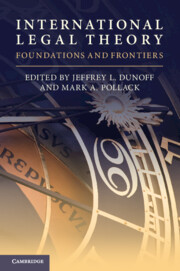Book contents
- International Legal Theory
- Reviews
- International Legal Theory
- Copyright page
- Contents
- Contributors
- Acknowledgments
- Part I Introduction: Setting the Stage
- Part II Traditional Approaches to International Law
- Part III Critical Approaches to International Law
- Part IV Post–Cold War Approaches to International Law
- 9 Global Administrative Law
- 10 Constitutionalism As Theory
- 11 Global Legal Pluralism
- Part V Interdisciplinary Approaches to International Law
- Part VI International Law: Dialogue and Dialectic
- Index
11 - Global Legal Pluralism
from Part IV - Post–Cold War Approaches to International Law
Published online by Cambridge University Press: 21 July 2022
- International Legal Theory
- Reviews
- International Legal Theory
- Copyright page
- Contents
- Contributors
- Acknowledgments
- Part I Introduction: Setting the Stage
- Part II Traditional Approaches to International Law
- Part III Critical Approaches to International Law
- Part IV Post–Cold War Approaches to International Law
- 9 Global Administrative Law
- 10 Constitutionalism As Theory
- 11 Global Legal Pluralism
- Part V Interdisciplinary Approaches to International Law
- Part VI International Law: Dialogue and Dialectic
- Index
Summary
Global legal pluralism, unlike many of the theoretical approaches explored in this volume, takes into view not just international law as such but inquires into the broader universe in which traditional international law, understood primarily as inter-state law, is embedded. It starts from the observation that in today’s global order multiple normativities – domestic, regional and international, formal and informal, private and public – interact and that this interaction is important for understanding the shape of the overall order. Global legal pluralism thus seeks to theorize the ways in which interactions between different normativities take place and their implications for a more general account of the structure of the global legal order. Some pluralists writing in this vein take a more analytical, others a more normative approach, but they all seek to capture situations in which law consists not of one, unitary legal order, but of a multiplicity of suborders with potentially competing claims to authority.
- Type
- Chapter
- Information
- International Legal TheoryFoundations and Frontiers, pp. 240 - 258Publisher: Cambridge University PressPrint publication year: 2022
- 1
- Cited by

